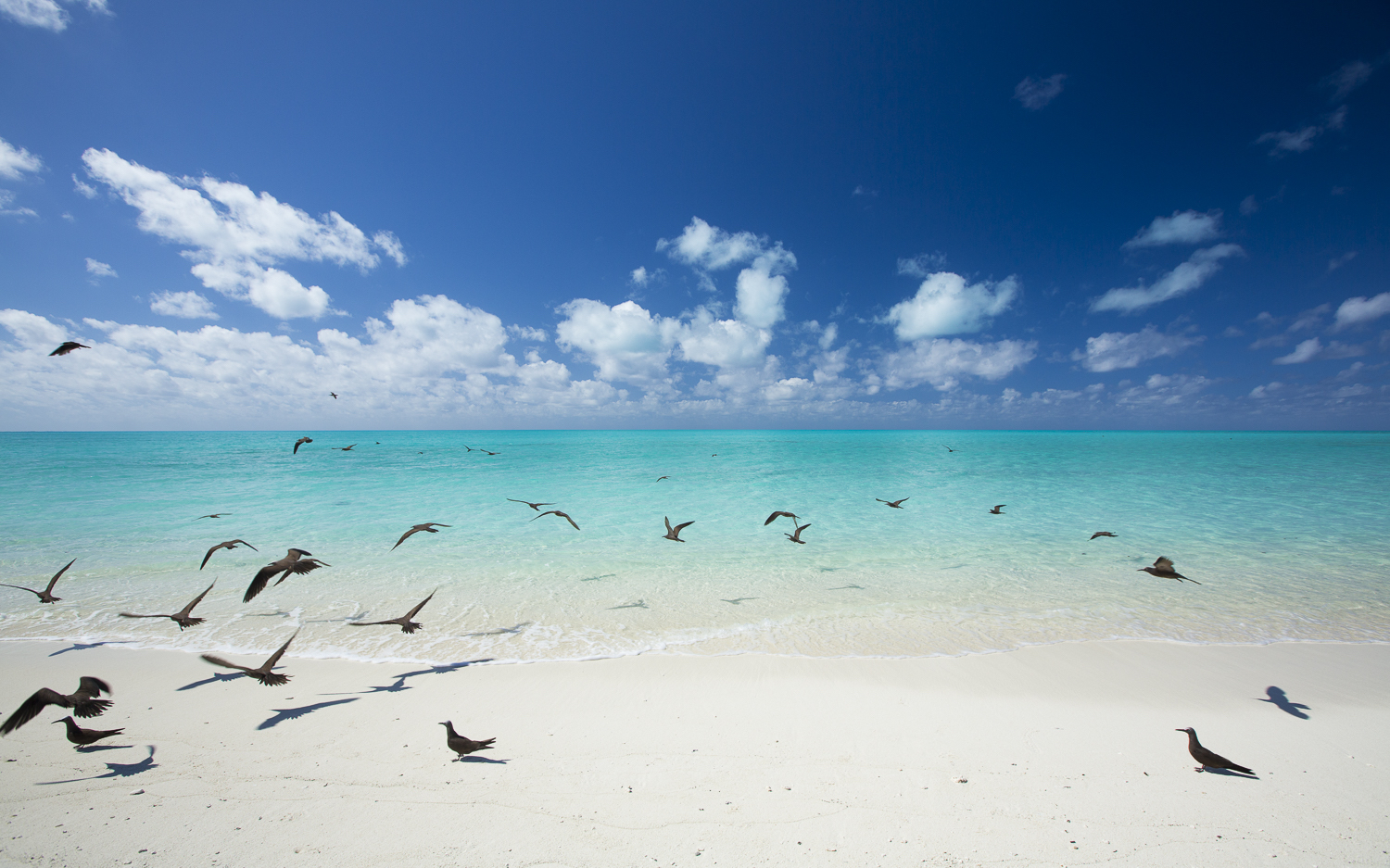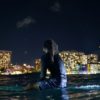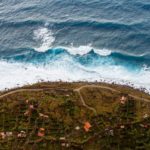After seven months spent on Kure Atoll, a conservationist reflects on its remote and challenging conditions.
I am standing alone on the highest point of Kure Atoll. I’m at the top of a sand dune overlooking the western side of the island. From my vantage point, I can clearly see waves crashing along the far side of the outer reef. The wind has suddenly shifted to the south, and I’m not surprised to see the beginnings of a squall, its path towards me direct yet unhurried. I am not concerned. I have time.
The lagoon flanking the island is set apart from the ocean by a coral reef delineating the atoll I have called home for the past seven months. In contrast to the nearly black ocean, the lagoon’s waters are a striking medley of the most vivid shades of blues and greens imaginable. As the squall crosses the reef, I watch, fascinated, as tendrils of rain draped below the billowing clouds turn a brilliant turquoise.
Suddenly, I feel a tug on my hat and instinctively duck as a pair of juvenile ‘iwa birds try to steal it. I hold the hat down with one hand and wave my other at them in an attempt to send them on their way. I have lost countless hats, sunglasses, pencils, and other objects to these mischievous birds.
Birds of a Feather
Unsuccessful, the ‘iwa birds eventually fly off in search of an easier target. Moments later, a magnificent mōlī (Laysan albatross) glides by my left shoulder, turning to gaze at me with intense yet curious eyes. Its gracefulness in flight belies its enormous seven-foot wingspan. Impervious to the impending squall, it ventures out over the lagoon, gently dragging the tip of its wing though the water’s surface as it banks steeply toward the open ocean in search of food.
Kure Atoll, also known as Hōlanikū or Mokupāpapa, is the furthest northwest of the Northwestern Hawaiian Islands and the Papahānaumokuākea Marine National Monument.

Kure Atoll, also known as Hōlanikū or Mokupāpapa, is the furthest northwest of the Northwestern Hawaiian Islands and the Papahānaumokuākea Marine National Monument.
It is the most northerly atoll in the world, lying roughly 1,400 miles northwest of O‘ahu. The remnant of an ancient volcano, the atoll has a circular reef that is at most six miles in diameter. I am standing on the atoll’s only island, a small, crescent-shaped spit of land totaling a mere third of a square mile in size, ringed by a continuous stretch of brilliant white sand.
Bordering the beaches are dense, tangled shrubs of naupaka, some of which reach more than 10 feet high. In the center is an open, grassy plain dotted with kawelu, a native bunch grass.
The island is quite flat, the highest point being roughly 20 feet above sea level. Kure is populated only by the hundreds of thousands of seabirds that come here each year to mate and raise their young, along with Hawaiian monk seals, green sea turtles, and other marine species.
I turn my attention back to the reef. Beyond is nothing but open ocean for thousands of miles, yet I know that in a short time the MV Imua, a 185-foot-long offshore supply vessel that brought me here from O‘ahu nearly eight months ago with a crew of seven others, will appear to take us back to civilization.
We arrived at the end of August with just enough food and supplies to sustain us for the duration of our time here. Since then, we have been the island’s only human inhabitants.
As I look over the island from the top of the dune, I try to imagine the pristine paradise it once was, a truly native island where wildlife thrived in perfect balance of give and take. However, over the past 200 years or so, humans have left their mark on this avian utopia, bringing with them invasive plants, insects, and diseases from other parts of the world that choked out the native flora, causing the populations of native fauna to plummet.
Every day the wildlife here struggle to survive amid the ever-encroaching hands of humankind. Albatross feed their chicks plastic they mistook for food while foraging on the open ocean. Netting and other debris cast aside by fishermen entangle critically endangered Hawaiian monk seals. Invasive plants that have naturalized themselves threaten the nesting habitat of the atoll’s native seabirds.
The State of Hawai‘i Department of Land and Natural Resources’ Division of Forestry and Wildlife established remote field camps on the island 25 years ago. The goal of the division, now supported by the Kure Atoll Conservancy, is to restore Kure Atoll as close to its natural state as possible, allowing its native inhabitants to thrive in a properly functioning ecosystem once again.
Small but dedicated crews of habitat restoration technicians such as myself arrive by ship after weeklong journeys by sea to spend either the winter or summer season living and working on this extremely remote outpost. There is no electricity or internet here.
Communication with the outside world is limited to short emails sent and received via satellite phone. All food and supplies are brought with crews and rain catchment is relied on for fresh water. Potential crew members are rigorously interviewed and ultimately chosen not only for their experience but also for their ability and willingness to live and co-exist in these remote and often challenging conditions.
Our days here are long and rigorous. We work to eradicate Verbesina encelioides, a tenacious and invasive plant that once covered most of the island’s open areas and made it difficult for albatross and other seabirds to successfully nest and raise their young.
Thousands of pounds of trash, mostly plastic and netting, litter the island, swept in with the currents from elsewhere. Knowing it is impossible to remove it all, we focus on collecting fishing lines, nets, and other marine pollution in which birds, seals, and turtles are most likely to get tangled.
We are heartened when we see the results of this collective work, both ours and of the decades of crew before us. Native plants are returning in areas that were once entirely covered in weeds, creating a better habitat for the island’s avian inhabitants and making it possible for future generations of seabirds to exist.
When birds and seals become caught in detritus that has made it to our shores, we free them from it and, in doing so, are rewarded by the knowledge that we have saved lives. By restoring and maintaining diversity among this isolated ecosystem, we are helping the much larger and more global ecosystem to function and thrive.

When I first arrived, I was told by members of the departing crew that Kure would change me. It has. Life here is incredibly simple, profoundly uncomplicated, and dictated almost entirely by nature. The absence of the constant thrum of noise associated with the outside world affords a sort of clear-headedness that doesn’t exist elsewhere.
The ability to focus becomes intensified and even exhilarating. Learning and adapting to ever-changing conditions and circumstances becomes almost instinctual. Here, we learn to make do with what we have on hand; anything more is considered unnecessary and even frivolous. When the trivial aspects of our lives slip away, we are left with profound appreciation of the importance of family and friends.
I can feel the wind begin to swirl around me as the squall inches its way toward the shoreline. A pillar of ‘iwa birds rises into the sky from the south. They are like an ever-changing constellation, slowly sweeping across the horizon using the thermals of the approaching storm to keep afloat. Together, the birds form a visible tattoo across the sky. I can almost feel their excitement and energy as the storm nears.
Behind me in the central plain are thousands of mōlī that have been our constant companions since their annual arrival in October. They are now working hard to raise and feed their young, and shortly, the surviving chicks will fledge and head into the great expanse of the Pacific to experience lives of voyaging and exploration. Anticipating the storm, the parents hunker down, protecting their chicks from the incoming rain and wind.

The squall has reached shore, and I can feel the first drops of rain. It is time to go. I head back to the one-story cinder block structure that has been our shelter through many storms this winter. The eight of us wait inside while the rain briefly batters the island and then, as with all the storms before, continues out to sea, where it meanders along at the whim of currents and winds until it finally peters out.
I will miss Kure Atoll and all the unique and quirky creatures that call it home: the stunningly graceful fairy terns whose tendency to lay their solitary eggs in the most precarious of spots defies gravity and common sense; the wild enthusiasm of the male ‘iwa birds, warbling loudly, their heads thrown back and their bright crimson gular pouches fully inflated while desperately trying to keep from falling off their perches in the naupaka; and finally, the mighty mōlī, whose regal presences reminds us daily of the importance of our work.
I will miss being at the mercy of the rawness and strength of nature’s elements and the extreme isolation that is difficult to find anywhere else. I will miss the moments that define our time here and the camaraderie forged from sharing these experiences. Memories tend to fade with time, but knowing that, in my own small way, I have contributed to preserving this remarkable place is an undeniable honor that will remain with me always.
When the last remnants of the squall have dissipated, we head outside once again. Upon hearing a shout announcing the ship’s arrival, I make my way down the path to the shoreline to greet the new crew members. As they disembark at the water’s edge and step onto Kure for the first time, I see reflected in their eyes the same mixture of excitement and nervousness that I felt months ago, and I tell them that the island will change them, too.





